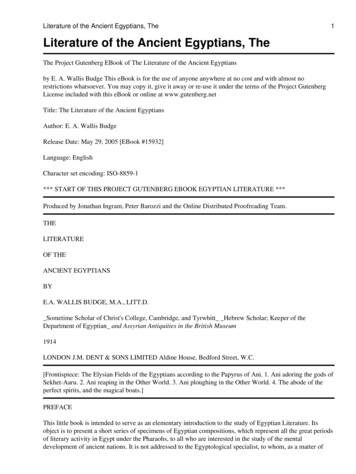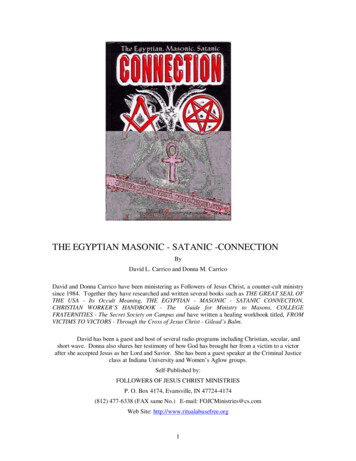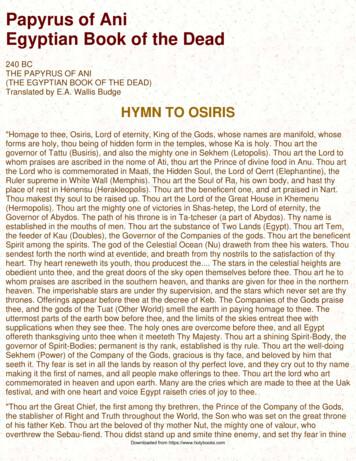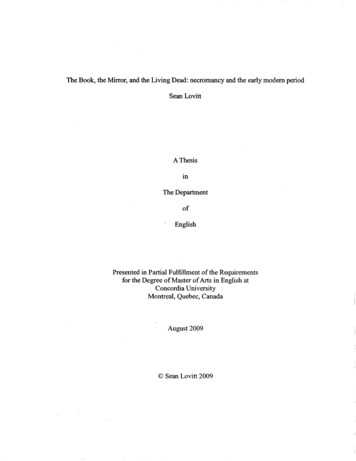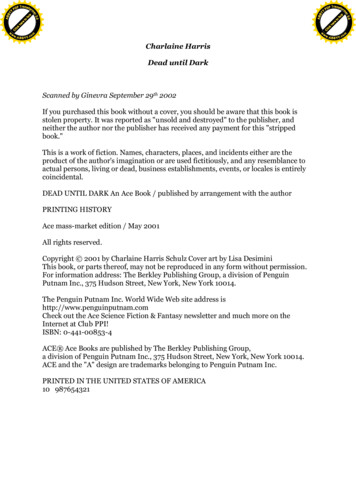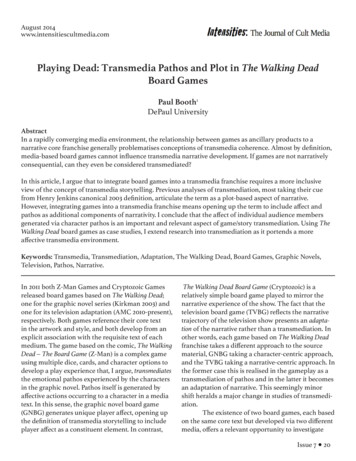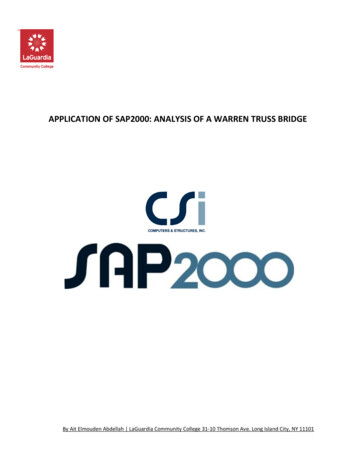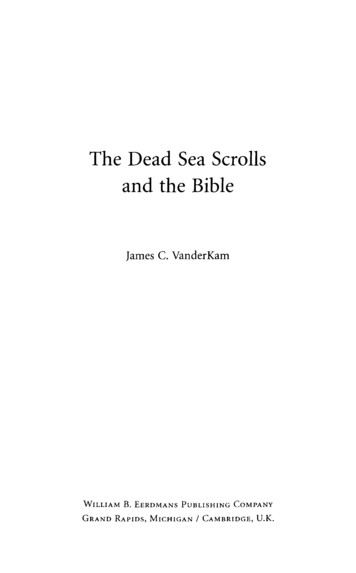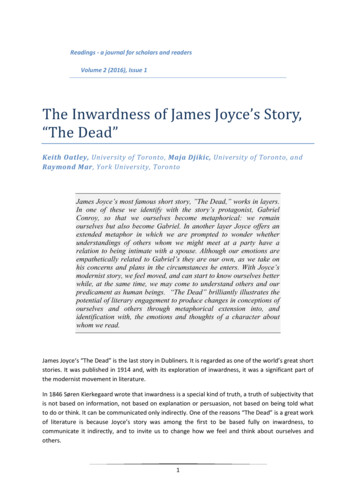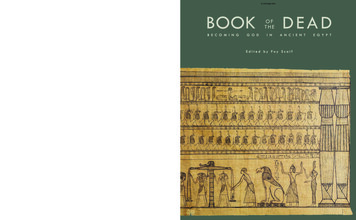
Transcription
oi.uchicago.eduBOOK OF THE DEADB E C O M I N GG O DI NA N C I E N TEdited by Foy ScalfE G Y P TS C A L F, e d .T H E O R I E N TA L I N S T I T U T E
oi.uchicago.eduBOOK OF THE DEAD1
oi.uchicago.eduDivine guardian before a netherworld gate as part of BD 146 from Papyrus Hynes. OIM E25389H Cat. No. 17 (D. 19871)
oi.uchicago.eduBOOK OF THE DEADBECOMING GOD IN ANCIENT EGYPTedited byFOY SCALFwith new object photography byKevin Bryce LowryORIENTAL INSTITUTE MUSEUM PUBLICATIONS 39THE ORIENTAL INSTITUTE OF THE UNIVERSITY OF CHICAGO
oi.uchicago.eduLibrary of Congress Control Number: 2017951669ISBN: 978-1-61491-038-1 2017 by The University of Chicago. All rights reserved.Published 2017. Printed in the United States of America.The Oriental Institute, ChicagoThis volume has been published in conjunction with the exhibitionBook of the Dead: Becoming God in Ancient EgyptOctober 3, 2017–March 31, 2018Oriental Institute Museum Publications 39Published by The Oriental Institute of the University of Chicago1155 East 58th StreetChicago, Illinois, 60637 USAoi.uchicago.eduCover IllustrationVignette of BD 125 from Papyrus Milbank.Egypt. Ptolemaic Period. 34.9 77.8 cm (framed). OIM E10486J. Catalog No. 15.Cover design by Foy Scalf and Josh TulisiakPhotography by K. Bryce Lowry: Catalog Nos. 1–15, 17–18, 24–28, 33–45Photography by Anna R. Ressman: Catalog Nos. 19–23Photography by Foy Scalf: Catalog Nos. 30–31Photography by John Weinstein: Catalog No. 16Photography by Jean M. Grant: Catalog No. 29Printed by Thomson-Shore, Dexter, Michigan USAThe paper used in this publication meets the minimum requirements of American National Standard for InformationService — Permanence of Paper for Printed Library Materials, ANSI Z39.48-1984.
oi.uchicago.eduTABLE OF CONTENTSForeword. Christopher Woods .Preface. Jean Evans.Introduction: Preparing for the Afterlife in Ancient Egypt. Foy Scalf.List of Contributors .Egyptian Chronology .Map of Principal Areas and Sites Mentioned in the Text.7911141718I. BIRTH OF THE BOOK OF THE DEAD1. What Is the Book of the Dead. Foy Scalf.2. The Origins and Early Development of the Book of the Dead. Peter F. Dorman.3. Language and Script in the Book of the Dead. Emily Cole.4. The Significance of the Book of the Dead Vignettes. Irmtraut Munro.21294149II. PRODUCTION AND USE5. How a Book of the Dead Manuscript Was Produced. Holger Kockelmann.6. The Ritual Context of the Book of the Dead. Yekaterina Barbash.7. Transmission of Funerary Literature: Saite through Ptolemaic Periods. Malcolm Mosher Jr.8. The Archaeology of the Book of the Dead. Isabelle Régen. . .67758597III. MAGIC AND THEOLOGY9. Divinization and Empowerment of the Dead. Robert K. Ritner.10. The Mysteries of Osiris. Andrea Kucharek. . .11. Gods, Spirits, Demons of the Book of the Dead. Rita Lucarelli. . .109117127IV. DEATH AND REDISCOVERY12. The Death of the Book of the Dead. Foy Scalf.13. The Rediscovery of the Book of the Dead. Barbara Lüscher.14. Necrobibliomania: (Mis)appropriations of the Book of the Dead. Steve Vinson.139149161V. CATALOGHuman Remains .Linen Bandages.Heart Scarabs.Sarcophagi and Coffins.Papyri Cases.Papyri.Magic Bricks. . .Funerary Figures. . .Stelae. . .Tomb Reliefs. .Statues and Figures of Deities.Scribal Materials. . .Checklist of the Exhibit .Concordance of Museum Registration Numbers 1357359361
oi.uchicago.edu
oi.uchicago.edu1. WHAT IS THE BOOK OF THE DEAD1. WHAT IS THE BOOK OF THE DEADFOY SCALFWhen most people think of the Book of theDead, they think of the large, well illustrated papyrus scrolls such as the famous papyrus of Ani (fig. 1.1). However, the use of the moderntitle “Book of the Dead” is very misleading, as whatwe call the Book of the Dead is a far more variable andcomplex set of texts. In fact, the Book of the Dead isnot a “book” in the modern sense of the term, neitherin narrative concept nor in physical format. Modernbooks with their bound pages are descendants of thecodex, a format in which a medium such as parchment or papyrus was folded and cut to produce facingpages (Clemens and Graham 2007, pp. 3–64). Groupsof these pages were then gathered together and sewnthrough the folded edge to produce the book block.A cover of wood or leather would have been attachedas a protective covering for the pages inside. Thecodex format became common in ancient Egypt onlyafter the second century ad (Bagnall 2009). Up untilthen, and for a time afterward, the primary formatfor “books” in ancient Egypt was the papyrus scroll.Making a papyrus scroll was a labor intensive undertaking. Long stalks of papyrus had to be harvested,cut, trimmed, and then beaten with a mallet into thinflat strips (Černý 1952). These strips were overlain oneach other lengthwise and further pounded, allowingthe gum resin in the papyrus plant to act as a naturalbinding agent. This process produced a thin sheet,yet too fragile for writing on. An additional sheet wasused as a second layer, laid over the first sheet withthe fibers of the papyrus at a perpendicular angle tothe first sheet, resulting in a sturdy page. On one sidethe fibers ran left to right horizontally. This side wasgenerally considered the front, also called the recto,FIGURE 1.1. Probably the most famous Book of the Dead manuscript, the papyrus of Ani was beautifully written andillustrated in the Nineteenth Dynasty. British Museum EA 10470, 4 ( Trustees of the British Museum)21
oi.uchicago.eduBOOK OF THE DEAD: BECOMING GOD IN ANCIENT EGYPTFIGURE 1.2. The title “The (Book) of Going Forth by Day” written to the right at the beginning of a Third Intermediatepapyrus belonging to Nany. Metropolitan Museum of Art, 30.3.31 (DT11632)used for the beginning of a text so that the writingran in parallel to the papyrus fibers. The other sidewith the fibers running vertically was generally considered the backside, also called the verso, in whichwritten text ran against the grain of the papyrus.Depending on when and where they were made,these sheets of papyrus were often fashioned toroughly standardized sizes, the full height of whichcould vary between around 30 to 50 cm. To produce ascroll, these individual sheets, which can be thoughtof as our modern book pages, were attached together by overlapping their edges, sometimes reinforcedby additional papyrus strips. For Book of the Deadmanuscripts, the scroll was often produced first andthe text and illustrations added later to the completescroll (Scalf 2015–16). However, certain examples,such as the Papyrus of Ani (fig. 1.1), clearly show thatindividual sheets of papyrus were first inscribed andillustrated and then attached together to form thescroll as a second step.The text and images on the scroll could be thework of a single scribe or an entire team of scribesand artists (Chapter 5). The finished product wouldhave served the same basic purpose as the modernbook — a medium to record, preserve, and store textual information. Unlike a book, however, the scrollwould have been rolled up for storage. A protectivesheet of blank papyrus was often joined to the outside edge to protect the beginning of the text fromdamage. Like manuscripts of the Medieval Period,each Book of the Dead manuscript was a hand-made,unique object. No two are exactly the same, althoughthose produced in the same funerary workshops bearmany similarities (Chapter 7). If no two Books of theDead were identical, what exactly did the textualcomposition consist of?The title “Book of the Dead” is a modern designation, derived from the German name Totenbuchused in the nineteenth century (Chapters 2 and 13),itself perhaps influenced by the Arabic phrase kutub22
oi.uchicago.edu1. WHAT IS THE BOOK OF THE DEADFIGURE 1.3. The weighing of the heart against Maat in the judgment scene before Osiris from the tomb of Menna. ThebanTomb 69 (photograph by Charles F. Nims, Oriental Institute)al-umwat “books of the dead” used by Egyptian villagers to describe papyri found in tombs (Quirke 2013,p. vii). Ancient Egyptians called the composition the“Book of Going Forth by Day” (tꜢ mḏꜢ.t n.t prı͗.t m hrw)(fig. 1.2) or the “Spells for Going Forth by Day” (rꜢ.wn.w prı͗. t m hrw). “Going forth by day” refers to thesoul, called the ba (bꜢ) in the Egyptian language, withits ability to leave the tomb, fly out into the daylight,and join the sun god in his journey across the heavens(figs. 1.4 and 4.1). Book of the Dead spell 15B, section3, elaborates on the concept of going forth by day:“As for any spirit (Ꜣḫ) for whom this book is made, hissoul (bꜢ) goes forth with the living. It goes forth byday. It is mighty among the gods” (T. Allen 1936, p.148). The title “Book of Going Forth by Day” was nota technical title and it actually did not designate asingle, particular book (Schott 1990, pp. 101, 168–70).It was a generic designation that could be applied tonearly any funerary composition that served a similar purpose and in fact had already appeared in theCoffin Texts (e.g., CT 94, 152, 335, 404) and continued to appear in the Ptolemaic Period in the Booksof Breathing (cf. P. Louvre N 3166, 1–4, Herbin 1999,p. 216). Even individual spells within the Book of theDead carried the title (e.g., BD 1–3, 64–66, 68).This so-called book, however, is not a singularnarrative composition with a beginning and an end.Rather, the Book of the Dead is a compilation of manysmaller texts. These smaller components are referredto as “spells” (rꜢ.w), both in the ancient texts and bymodern scholars. Further echoing the comparisonwith books, some publications also refer to the individual spells as “chapters.” Each individual spell wasessentially a self-contained unit with its own themeand structure. Some spells are very long, such as Bookof the Dead spell 17, otherwise abbreviated BD 17, astyle you find throughout this and other publications.Other spells are very short, such as BD 6, the ushabtispell. Individual spells were often, although not always, combined with specific illustrations, referred23
oi.uchicago.eduBOOK OF THE DEAD: BECOMING GOD IN ANCIENT EGYPTBook of the Dead spells were often inscribed in allthese places for an individual with the means to afford it. This created an embedded redundancy bysurrounding the dead within a magical cocoon andensured that if the spells from one copy were damaged, a second or third copy was available to effectits magical intent.This metaphor of “wrapping” the dead in magical spells had a very literal physical manifestation.Book of the Dead spells were frequently written onlinen shrouds or bandages (Cat. Nos. 2–5) and thenwrapped around the corpse (Chapters 2 and 5). Justas with papyri, the layout and format changed anddeveloped over time and place. In the Ptolemaic Period (332–30 bc), it was especially common to inscribethe spells on thin linen strips in wide columns of hieratic texts accompanied by illustrations (fig. 1.5).When many spells were included, a large number ofstrips would have been used, both to accommodateall the spells, but also to fully wrap the body (Cat.No. 1). Several rare examples attest to a practice ofplastering a Book of the Dead papyrus directly to themummy and it appears that the spells were laid outon the papyrus to coincide with their placement overparticular body parts (Illés 2006a).The mummified body could be inserted into acasing made of cartonnage, a semi-hard shell formedfrom layering sheets of linen and papyrus coveredwith plaster. Cartonnage mummy cases (fig. 1.6) andcoffins alike (fig. 1.7) served as important canvasesfor funerary decoration and text (Chapters 2 and3). Book of the Dead spells were commonly appliedto these objects, ranging from spell excerpts (fig.1.6) to entire sequences consisting of dozens ofFIGURE 1.4. The ba-soul of Neferrenpet is shown returningto the corpse in the tomb at night in a vignette from hisfunerary papyrus. Brussels MRAH E. 5043 ( WernerForman / Art Resource, NY)to as vignettes, which provided a visual componentto the spells’ content. The most famous of these vignettes is the judgment scene accompanying BD 125,in which the heart of the deceased is weighed againstthe feather of Maat in the hall of Osiris (fig. 1.3). Somespells, such as BD 16, consisted only of the illustrationitself (see overleaf to Section IV on p. 137).Since the Book of the Dead was a collection ofindividual compositions, by extension the Book ofthe Dead therefore appears on many other media beside papyrus as each spell could be inscribed aloneor in groups of spell sequences. Spells were inscribedon every form of media available, including papyri,leather, linen bandages, cartonnage mummy cases,coffins, sarcophagi, funerary figures, stelae, magicbricks, and even on the walls of the tomb. In fact,FIGURE 1.5. A linen bandage inscribed with the text and vignettes from BD 17 would have been wrapped around themummified body of its owner, the “Osiris, royal scribe, Pankhered, whom Taremetenbastet bore,” prior to burial. Egypt.Linen and ink. H: 7 x W: 41 cm. Ptolemaic Period. Gift from the Estate of Dr. Charles Edward Moldenke, 1935. OIM E19443A(D. 19933)24
oi.uchicago.edu1. WHAT IS THE BOOK OF THE DEADspells inside and out (fig. 1.7). During eras whenthe production of Book of the Dead papyri waned,such as the time between the Twenty-second andTwenty-fifth Dynasties, it is likely that inscribingspells on coffins and related mortuary materialserved as the primary means for transmitting them(Munro and Taylor 2009). A wooden board fragmentfrom a Twenty-fifth to Twenty-sixth Dynasty coffinbottom, now in the Oriental Institute, shows justhow extensive this decoration could be (fig. 1.7). Thehorizontal rows of cursive hieroglyphs that appearedon the interior of the coffin begin with an offeringformula and transition into BD 1. The spells on theback side from the exterior of the coffin contain BD89 and 90. Similar such coffins could be covered withan essentially complete copy of the Book of the Deadcontaining dozens of spells (Taylor 2010a, pp. 74–75,no. 29). Recent research has even shown that papyrifrom the Twenty-fifth Dynasty may have been copiedusing coffins as the model for the Book of the Dead(Quirke 2013, pp. xiii–xiv; Munro and Taylor 2009).The largest canvas for the Book of the Dead wasthe walls of the tomb itself (Cat. Nos. 30–31). Carvingthe spells and their illustrations in stone must havebeen a tremendous investment, but could producea long-lasting, oversize copy that would have beenstriking to see in full color. It was common for kingsand queens of the New Kingdom to inscribe sets ofspells either on objects in the mortuary assemblage,or, especially in the later New Kingdom, in stone onthe walls within their burial chambers. Since no Bookof the Dead papyri belonging to a pharaoh are thusfar attested, it is likely that the spells on the wallsand objects in the tomb were the primary copies forthese kings (Scalf 2016, pp. 209–10). Some of the mostspectacular copies on tomb walls derive from theTwenty-fifth to Twenty-sixth Dynasties and it seemsthat the same priests who were copying older textsfor application on coffins were doing likewise for thetomb (Einaudi 2012).The appearance of Book of the Dead spells onindividual objects within the funerary assemblageraises some interesting questions about the development (Chapter 2), use (Chapter 8), and transmission (Chapter 7) of the Book of the Dead. Many of thespells have obvious origins in the corpora of funerary compositions that had preceded them, namelythe Pyramid Texts and Coffin Texts. Separating thespells into Pyramid Texts, Coffin Texts, and Book ofthe Dead spells is an arbitrary convention of modernscholars as it is clear that the ancient Egyptians sawall of these compositions on a single continuum, evenif they had popular presentation in particular contexts such as in pyramids, on coffins, or on papyri.FIGURE 1.6. This fragment of a cartonnage mummy caseis decorated with BD spell 18, which wished for Thoth tojustify the deceased against his enemies just as he justifiedOsiris against his. Egypt, Thebes. Cartonnage and paint.H: 28 x W: 6.6 cm. Third Intermediate Period, Twentysecond Dynasty. Gift of the Egypt Exploration Fund, 1895–6. OIM E1338 (D. 19798)25
oi.uchicago.eduBOOK OF THE DEAD: BECOMING GOD IN ANCIENT EGYPTOther spells did not derive directly from these earliertexts. In the few cases where we have evidence of aspell’s origin, this evidence often points toward thefact that the “classic” Book of the Dead manuscriptsprobably played a secondary role in their origin andtransmission.Many spells contain instructions on their usethat do not call for their incorporation into a largerpapyrus compilation. These instructions were commonly written in red, like the titles of the spells, andare referred to as rubrics, a term derived from Latinrubrica (“red ochre”) in reference to the use of red tohighlight specific letters in Medieval manuscripts. Incertain cases, the rubrics describe how the spell wasintended to be used in conjunction with a particularamulet. For example, BD 30B is a spell for preventingthe heart from condemning a man in the judgmenthall (Cat. Nos. 6–9). The associated rubric instructsthat the spell is to be written on and recited overa scarab made from green stone. It is likely, therefore, that the written version of this spell originatedas an amuletic text employed with these particularartifacts and it probably had a longer history of oraltransmission for which we have no written evidence.The spell would have then only secondarily been incorporated into manuscripts with large collectionsof spells that we know as the Book of the Dead. Support for this reconstruction is found in particularfor BD 30B. Some of the earliest attestations of spellsfrom the corpus designated as the Book of the Deadconsist of copies of BD 30B found on heart scarabsfrom the Thirteenth Dynasty (Quirke 2013, p. 100),prior to any attestations of the spells on papyrus.Thus, the earliest attested Book of the Dead spell isnot on a Book of the Dead at all, but on a heart scarab.A similar hypothesis of transmission can beproposed for many other spells. Recent scholarshipon BD 151 (Chapter 8), a group of spells inscribed onmagical bricks (Cat. Nos. 19–23), has demonstratedthe existence of separate traditions for versionsfound on bricks versus copies found on papyri (Theis2015). BD 6, the so-called ushabti spell, clearly hada very particular purpose associated with funeraryfigurines (fig. 1.8). This association was so closeFIGURE 1.7. The exterior (left) and interior (right) of a wooden coffin fragment of Muthetepti from a Twenty-fifth toTwenty-sixth Dynasty coffin inscribed with BD spells in vertical, polychrome columns and rows. Egypt. Wood and paint.H: 61.3 x W: 26.2 x D: 4.8 cm. Gift of the Maynard Brothers, 1924. OIM E12145 (D. 19826 and D. 19827)26
oi.uchicago.edu1. WHAT IS THE BOOK OF THE DEADunderstanding this material is radically differentthan that of the ancient Egyptians themselves. Insome ways this is inevitable, but it is important tokeep in mind the different perspectives. Our modern concepts can help us articulate our advancesin interpretation, but they can also mislead us intomisinterpretations (Chapter 14), applying intentions,messages, or conclusions that never existed in theancient mind.that there is even a specific variation of the spellknown only from the funerary figurines of pharaohAmenhotep III (Cat. No. 24). Of course, when thesespells were first written down, there was probably acomplex interaction between single spells written onsheets of papyrus as memory aids or templates versusthe use of the texts on the amulets themselves.For the Book of the Dead, variation was the rule.Manuscripts were individually hand-crafted objects.Spells could appear alone, as part of short sequences,or in massive collections of more than 160. Any surface capable of being inscribed acted as a medium fortheir transmission. Each spell itself had many different variations and versions, some nearly unrecognizable when compared next to each other (Chapter 7).A comparison of the texts on Papyrus Ryerson (Cat.No. 14) with Papyrus Milbank (Cat. No. 15) demonstrates how different even two contemporary manuscripts can be from one another. Some compositions we label as individual spells did not even havea stable text at all. For example, despite extremelydivergent texts, the designation BD 15 has been applied widely to nearly any solar hymn, while Navilledesignated any Osirian hymn as BD 185 (Quirke 2013,pp. 33 and 479). This demonstrates the elusivenessof defining exactly what a Book of the Dead is. It isone of those objects that seems to confirm the rule:we know it when we see it. Looking closely at theformat and contents of the Book of the Dead revealsa complexity glossed over in most popular notions ofit and the necessity of nuance when trying to separate our modern interpretations of what it meantand how it worked from the ancient understandingthat produced it. Both approaches can be useful, butit is easy to be led astray by our modern bias and theconfusion that can often result from the complexity of the scholarly apparatus erected to buttress ourconclusions.When all of the above is taken into consideration,it is clear that answering the question “what is theBook of the Dead” is very different from answeringthe question “what was the Book of the Dead.” Inmany ways, the Book of the Dead is a modern construction of our imagination. Our conceptions aredictated by the way we categorize the texts, how weprivilege particular formats (e.g., papyri), what wesee as the ultimate purpose, and even what name wegive to the ancient compositions. In most of thesecases, our conceptual apparatus for discussing andFIGURE 1.8. A funerary figurine (ushabti) of pharaohRamesses III. Egypt, Thebes. Calcite. H: 29.6 x W: 11 xD; 7 cm. New Kingdom, Nineteenth Dynasty. Purchased inEgypt, 1920. OIM E10755 (D. 19773)27
oi.uchicago.eduBIBLIOGRAPHYAbt, Jeffrey20111950American Egyptologist. The Life of James Henry Breastedand the Creation of His Oriental Institute. Chicago: University of Chicago Press.1952Agarwal-Hollands, Usha, and Richard Andrews2001“From Scroll to Codex- and Back Again.” Education,Communication & Information 1: 59–73.1960Albert, Florence2012“Amulets and Funerary Manuscripts.” In Grenzen desTotenbuchs. Ägyptische Papyri zwischen Grab und Ritual,edited by M. Müller-Roth, M. Höveler-Müller, pp.71–85. Rahden: Verlag Marie Leidorf.1974Albert, Florence, and Marc Gabolde2013“Le papyrus-amulette de Lyon Musée des Beaux-ArtsH 2425.” Égypte Nilotique et Méditerranéenne 6: 159–68.Occurrences of Pyramid Texts with Cross Indexes of Theseand Other Egyptian Mortuary Texts. Studies in AncientOriental Civilization 27. Chicago: University of Chicago Press.“Additions to the Egyptian Book of the Dead.” Journalof Near Eastern Studies 11: 177–86.The Egyptian Book of the Dead: Documents in the OrientalInstitute Museum at the University of Chicago. OrientalInstitute Publications 82. Chicago: University ofChicago Press; The Oriental Institute, Reprint 2010.The Book of the Dead or Going Forth by Day: Ideas of theAncient Egyptians Concerning the Hereafter as Expressedin Their Own Terms. Studies in Ancient Oriental Civilization 37. Chicago: University of Chicago Press.Andreu-Lanoë, G., editor2013L’art du contour. Le dessin dans l’Égypte ancienne. Paris:Louvre éditions.Alexander, Shirley1965“Notes on the Use of Gold-leaf in Egyptian Papyri.”Journal of Egyptian Archaeology 51: 48–52.Andrews, Carol1994Amulets of Ancient Egypt. London: British MuseumPress.Allen, James P.1976“The Funerary Texts of King Wahkare Akhtoy on aMiddle Kingdom Coffin,” in Studies in Honor of GeorgeR. Hughes, edited by Janet H. Johnson and Edward F.Wente. Studies in Ancient Oriental Civilization 39,pp. 1–29. Chicago: University of Chicago Press.1996“Coffin Texts from Lisht.” In The World of Coffin Texts:Proceedings of the Symposium Held on the Occasion of the100th Birthday of Adriaan De Buck, edited by Harco Willems, pp. 1–15. Egyptologische Uitgaven 9. Leiden:Nederlands Instituut voor het Nabije Oosten.2005The Ancient Egyptian Pyramid Texts. Writings from theAncient World 23. Atlanta: Society of Biblical Literature.2006The Egyptian Coffin Texts, vol. 8: Middle Kingdom Copiesof Pyramid Texts. Oriental Institute Publications 132.Chicago: The Oriental Institute.2015The Ancient Egyptian Pyramid Texts. 2nd Revised Edition. Writings from the Ancient World 38. Atlanta:Society of Biblical Literature.Anthes, Rudolf1974“Die Berichte des Neferhotep und des Ichernofretüber das Osirisfest in Abydos.” In Festschrift zum 150jährigen Bestehen des Berliner Ägyptischen Museums, pp.15–49. Berlin: Akademie-Verlag.Assmann, Jan1986“Verklärung.” In Lexikon der Ägyptologie, edited byWolfgang Helck and Eberhard Otto, vol. VI, cols.998–1006. Wiesbaden: Harrassowitz.1995“Unio liturgica: Die kultische Einstimmung in götterweltlichen Lobpreis als Grundmotiv.” In Secrecyand Concealment: Studies in the History of Mediterraneanand Near Eastern Religions, edited by H. G. Kippenbergand G. Stroumsa, pp. 37–60. Leiden: Brill.1997Moses the Egyptian: The Memory of Egypt in WesternMonotheism. Cambridge: Harvard University Press.2001The Search for God in Ancient Egypt. Translated byDavid Lorton. Ithaca: Cornell University Press.2005Death and Salvation in Ancient Egypt. Translated byDavid Lorton. Ithaca: Cornell University Press.2008Altägyptische Totenliturgien III. Osirisliturgien in Papyrider Spätzeit. Supplemente zu den Schriften der Heidelberger Akademie der Wissenschaften, Philosophisch-Historische Klasse 20. Heidelberg: Universitätsverlag Winter.Allen, Thomas George1916Horus in the Pyramid Texts. A Private Edition. Distributed by the University of Chicago Libraries.1923A Handbook of the Egyptian Collection of the Art Instituteof Chicago. Chicago: University of Chicago Press.1936“Types of Rubrics in the Egyptian Book of the Dead.”Journal of the American Oriental Society 56: 145–54.Assmann, Jan, and Andrea Kucharek2008Ägyptische Religion: Totenliteratur. Frankfurt am Main:Verlag der Weltreligionen.361
oi.uchicago.eduBIBLIOGRAPHYBarguet, Paul1967Le Livre des Morts des anciens Égyptiens. Littératurea
title “Book of the Dead” is very misleading, as what we call the Book of the Dead is a far more variable and complex set of texts. In fact, the Book of the Dead is not a “book” in the modern sense of the term, neither in narrative concept nor in physical format. M


